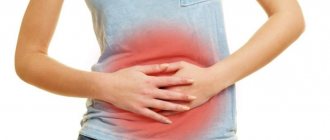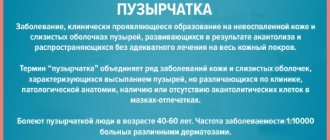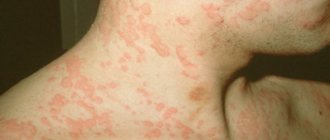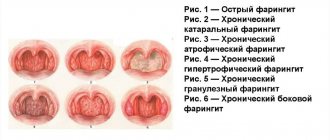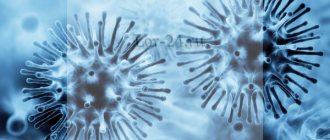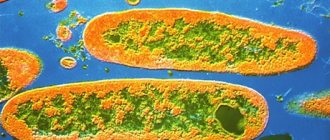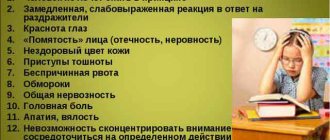The digestive tract is the most vulnerable system of our body. Every day, a significant amount of food and water of varying quality passes through it, which can be contaminated with bacteria, toxins, microscopic fungi, etc.
Getting into the cavity of the stomach and intestines, they begin to destroy the cells of these organs and disrupt digestion. There are a large number of microorganisms that lead to acute intestinal infections, but most often these diseases occur due to Rotaviruses.
More than a billion cases of this infection are reported worldwide every year. According to statistics, every second family encounters rotaviruses at least once. Moreover, most often children under 10 years of age get sick.
Adults, as a rule, become infected while caring for their child, but it is also possible for the microorganism to enter from another source. Given such a wide prevalence of pathology, you should be wary of any signs of an intestinal infection and, if you suspect it, seek the help of a doctor.
What it is?
This genus includes 9 types of rotaviruses, of which only 3 (A, B and C) can infect the human small intestine; type A is the most commonly diagnosed.
Rotavirus can exist for a long time in the external environment, settling on furniture, clothing, food, and getting into water. When entering the body, it first passes through the acidic environment of the stomach, then the virus infects the enterocyte cells of the villi of the small intestine and begins to reproduce its copies at high speed.
When a certain concentration of the virus in the cell is reached, the latter dies and copies of the viruses are released into the intestinal environment. A certain amount of viruses is eliminated from the body, but most continue to capture new enterocytes and actively reproduce.
Clinical signs of rotavirus
A severe clinical sign of this disease is dehydration, which is not inherent in other bacterial agents, but in combination with the symptoms of rotavirus enteritis is the cause of high mortality in this infection.
The most common clinical sign of the disease is manifestations of enteritis and gastroenteritis, the formation of secondary lactose deficiency. Against this background, the doctor recommends excluding all dairy products from the diet of children with rotavirosis. They can be administered after the end of the illness, and keep in mind that there is a high probability of relapse of diarrhea, since bacterial fermentation of lactose occurs in the intestines. Each infection gives the body immunity to a specific type of virus, and in case of repeated infection with the same serotype, the disease is much easier.
Epidemiology
Rotavirus is widespread throughout the world. According to studies, in developing countries with an average standard of living, it accounts for half of all intestinal disorders and is most often diagnosed in children under 2 years of age. In the United States, more than 1 million cases of severe diarrhea occur each year in children ages 1 to 4 years. Parents and caregivers should be aware that of this group, approximately 150 children die due to complications.
Conducted studies show that children over 14 years of age have a greater number of antibodies in the blood, which indicates the widespread spread of the virus. Despite the insignificant manifestation of symptoms at older ages, the number of carriers of infection that can unintentionally infect children increases significantly.
There is a lot of controversy regarding immunity. The study revealed that in Germany and Japan, patients developed antibodies of serotypes 1 and 3. However, the type of antibody serotype may vary depending on the time of year and other factors. The weakening of the immune system due to old age means that symptoms can appear in both children and the elderly.
Can I take antibiotics?
Antibiotics
It is useless to take antibiotics for rotavirus. Antimicrobial agents are effective only against pathogenic bacteria. Intestinal flu is caused by viruses, which differ from microorganisms in structure and effect on the body.
Antibacterial drugs are prescribed only when a bacterial infection develops against the background of rotavirus. You can get sick on the 3rd–4th day of development of the pathology.
Uncontrolled use of antibiotics can provoke the development of dysbiosis. Antimicrobial agents have a detrimental effect on the intestinal microflora, which causes a weakening of the immune system. This makes it easier for the viral infection to spread further.
What happens in the body after infection?
During rotavirus infection, there is a standard cycle of virion replication in the human body. The pathogen multiplies in the epithelial cells of the upper intestines, which die in large numbers. They are replaced “urgently” by immature epithelium, which cannot absorb water. The result is loss of fluid and electrolytes.
However, the main cause of profuse diarrhea and dehydration is osmotic diarrhea: a large amount of unbroken sugars accumulate in the intestines, since the cells are immature. As a result of the osmotic pump, water is intensively “pumped out” into the intestinal lumen. It is interesting that a disorder such as diarrhea is the same as the mating plumage of a beautiful bird or butterfly: the bird attracts a partner, which increases the chances of reproduction, and profuse diarrhea sharply increases the chance of the virus spreading over a large area, which leads to reproduction and prosperity kind.
After an infection, intestinal recovery usually ends by 5–8 weeks, except for secondary dysbiosis, which must be corrected. As for the various variants of the course and classification, there are two forms of the disease - typical and atypical:
- the typical form is gastroenteritis with all the classic symptoms, which will be discussed in detail below”; it can occur in mild, moderate or severe form;
- the atypical form is the most dangerous in epidemic terms, especially in adults.
There may be a mild course (in which there is an episode of loose stools during the day) or completely asymptomatic, in which the virus multiplies in the intestines without causing diarrhea. This has been proven by studies during outbreaks of infection, when healthy contacts not only isolated viruses in the feces, but also recorded a significant immune response.
Reviews from patients and specialists
According to experts and parents of children treated with antiviral drugs, the drugs speed up recovery and stimulate the body's immune defense. Parents noted a mild course and rapid recovery during treatment with Viferon.
Unlike the latter, Anaferon is less effective and has received less positive feedback from patients, but they note a good effect when used for prevention.
Symptoms of rotavirus infection in adults
The main symptoms of rotavirus infection are caused by damage to the intestinal mucosa and impaired absorption of nutrients, as well as disruption of the immune system and the entire body as a whole.
The onset of the disease is usually acute, characterized by a sharp increase in temperature, repeated vomiting, cramping pain and rumbling in the abdomen, and the development of diarrhea is possible. The nature of the stool helps diagnose rotavirus infection. On the first day of illness, the stool is liquid yellow in color; in subsequent days, the stool becomes gray-yellow with a clay-like consistency. In addition to intestinal manifestations of the disease, patients are bothered by a runny nose, sore and sore throat, and cough.
The above symptoms are more typical for children. In adults, symptoms of rotavirus are often similar to a common digestive disorder. Possible loss of appetite, loose stools, increased body temperature, which persist for a short time. Often, rotavirus infection in adults is asymptomatic, however, they are infectious to others. If there is a sick person in a team or family, then the people around him begin to get sick one by one.
Symptoms of rotavirus infection can be very similar to signs of other infectious diseases (salmonellosis, cholera), so if they appear, especially in young children, you should call a doctor. Under no circumstances should you give your child pain medications before consulting a doctor, as this may mask the symptoms of more serious illnesses.
Complications
It is important to recognize rotavirus in a timely manner and eliminate negative consequences. Maximum control throughout the entire period of illness should be aimed at replenishing the lost volume of fluid.
Attention! If a child with rotavirus is undergoing outpatient treatment, but responds to any fluid intake by vomiting, urgent hospitalization is necessary. Urgent recovery with IVs is required. Vomiting can lead to catastrophic dehydration, which can be fatal.
If in the first days after rotavirus the child does not eat anything, do not worry too much and force feed him. It is much more important to maintain a drinking regime, offering frequent snacks from permitted foods, but without trying to force him to eat. Proper recovery from rotavirus infection minimizes the negative impact of the disease on health.
Parents should pay close attention to the well-being of children if severe dehydration and the appearance of a pronounced acetonemic state have occurred.
It is important to check your kidney function, the following consequences are possible:
- Gasser syndrome.
- Infectious-toxic kidney.
- Acute renal failure.
If your stomach hurts after rotavirus, this is a reason to undergo additional examination. The disease itself usually does not cause pain after recovery, but it can damage the intestines. If the pain is combined with dark stools or blood in the stool, then you need to urgently seek medical help.
In most cases, the disease passes without consequences, but its course always causes severe stress for the body. To protect a child from rotavirus infection, timely prevention is necessary.
Features of the disease in adults
Rotavirus in adults occurs calmly, without significant intoxication. Often, people with an actively working immune system and high acidity of gastric juice have no symptoms at all. Some patients mistake clinical pathology for an intestinal disorder.
Symptoms of rotavirus infection in adults:
- Malaise,
- Low-grade fever,
- Nausea,
- Epigastric pain
- Diarrhea,
- Signs of rhinitis,
- Light cough.
Asymptomatic individuals are contagious. An infected person who is in a family or group poses a danger to others. Within 5 days, everyone suffers the infection one by one. In elderly people and people weakened by chronic pathologies, stress and other unfavorable factors, rotavirus diseases develop severely.
The infection is quite dangerous for pregnant women. This is due to the detrimental effects of dehydration on the fetus. Intestinal contractions and bloating often cause a reflex spasm of the uterine muscles, which threatens premature birth or miscarriage.
How to distinguish rotavirus from poisoning?
Rotavirus at the initial acute stage of manifestation of primary symptoms is often confused with poisoning. In this case, even doctors can make mistakes, in particular therapists who do not have the necessary experience or who delay in fully diagnosing the patient.
Indeed, the external manifestations of intoxication in both pathological cases are very similar - these are systemic dyspeptic disorders, increased temperature, tachycardia with increased blood pressure, changes in the consistency and nature of urine and feces. In classical medical literature, when carrying out the first differential diagnosis, it is recommended to pay attention to symptoms such as sore throat, severe lacrimation, cough, redness of the mucous membranes of the respiratory tract - they are formed during the oral penetration of rotavirus infection into the body with the subsequent reproduction of virions in the intestines.
However, it is worth considering that it is possible to distinguish between poisoning and rotavirus infection only if the former is in the nature of food intoxication or an overdose of certain medications. In case of poisoning with organophosphorus compounds, heavy metals, and cumulative cauterizing poisons, the symptoms of the acute period may be identical, especially if we are not talking about vapor toxicity (where the bronchopulmonary system primarily suffers), but about the direct oral route of penetration of the pathogen.
Based on the above arguments, it can be argued that it is guaranteed to distinguish between rotavirus infection and poisoning in 100 percent of cases only after receiving test results - classical PCR and microscopy, or using an express method.
How to treat rotavirus infection?
At home, to treat rotavirus in adults, it is necessary to remove microorganisms from the intestine that are located on its walls and destroy cells. For this purpose, you can use adequate doses of sorbent drugs, such as:
- Activated carbon - up to 4-6 tablets per dose several times a day;
- Smecta or Neosmectin (domestic analogue) – 3-4 sachets per day;
- Enterodes or Polysorb – 1-2 sachets per day.
For infants, the amount of medication is selected individually, depending on the child’s condition. Some forms of drugs are quite difficult to get an infant to drink. To simplify the process, preference should be given to syrups and medicinal solutions. The tablets can be dissolved in water or finely crushed and given on a teaspoon.
In addition to enterosorbents, the drugs Anaferon and Arbidol have proven their effectiveness against rotaviruses. During research, doctors discovered that their use speeds up the treatment of infection by several days.
There are no specific drugs whose action is aimed at destroying rotaviruses. Treatment measures are aimed at combating the symptoms of the disease.
Elimination of dehydration and intoxication
This is one of the most important components of treatment, which can improve the general condition of a patient of any age. You can compensate for the loss of water and minerals necessary for the body with the help of medications: Regidron, Glucosolan, Gastrolit.
If none of the listed medications are in your home medicine cabinet, for the first time you can prepare a solution similar in composition to these medications. To do this, add to 1 liter of boiled water:
- 4 tablespoons (20 g) sugar;
- 1 teaspoon (3 g) salt;
- 1 teaspoon (3 g) baking soda.
However, it should be remembered that it is better to use this solution only for a short time, before purchasing medications, since it lacks a number of important microelements.
Restoring bowel function
Rotavirus infection destroys some of the beneficial bacteria that are necessary for effective digestion. That is why it is necessary to include probiotics in therapy, such as Lactofiltrum, Linex, Bifidum, Bifidumbacterin, etc.
general description
Rotavirus infection is also defined as RI, rotavirus gastroenteritis, rotavirosis, stomach or intestinal flu. The virus is transmitted primarily through food, that is, through unwashed food, dirty hands, etc.
Thus, infection is possible in a variety of ways and, again, through products with rotavirus (in particular, dairy products should be highlighted here, which are especially susceptible to infection due to the specifics of their production). It is noteworthy that rotaviruses can live even in the refrigerator for a long period of time; chlorination of water does not affect them. Contrary to the generally accepted opinion regarding the effect of holy water on viruses due to its altered structure, it should be emphasized that it does not in any way affect the activity of rotaviruses.
Considering that rotavirus also provokes inflammation in the respiratory tract, its spread occurs in a similar way to the traditional influenza virus, that is, by droplets (coughing, sneezing). The virus penetrates the mucous membrane of the gastrointestinal tract (GIT), with the small intestine being predominantly affected. When the gastrointestinal tract is affected, rotavirus infection causes a disease such as enteritis, which manifests itself in inflammation of the intestinal mucosa, respectively, after which symptoms characteristic of rotavirus infection occur. They are expressed, in particular, in disturbances in the digestion of food, which provokes the development of diarrhea with simultaneous dehydration.
Prevention
There is a list of personal prevention measures that must be observed directly by each person to prevent the development of the disease, and a list of anti-epidemic measures that should be carried out in medical institutions and children's institutions. Personal preventative measures include:
- Always try to keep apartments, houses and other residential premises clean.
- Carefully monitor the cleanliness of children's hands, especially after walking outside and before eating.
- Drink only boiled or bottled water, as well as boiled milk.
- Be sure to wash any vegetables and fruits well before eating them, rinsing them with boiling water.
- Keep dishes clean, especially children's dishes.
It is imperative to isolate a sick person from other family members, providing him only with separate dishes, towels and other items related to personal hygiene intended for him.
Which doctor should I contact?
An infectious disease specialist is involved in the diagnosis and treatment of patients with rotavirus infection. At the same time, it is worth noting that when the first symptoms of the disease appear, people usually turn to their family doctor, pediatrician (if a child is sick) or call an ambulance. That is why a doctor of any specialty must be able to recognize the symptoms of this pathology and promptly refer the patient to an infectious disease specialist.
Intestinal infection in children Intestinal flu Irritable bowel syndrome Intestinal cancer Intestinal dysbiosis Intestinal colitis
Diet for treating illness
Throughout the entire period of illness, the patient needs to eat properly in order to alleviate his condition as much as possible. The drinking regime is of particular importance here. To prevent fluid loss, you need to drink as much as possible, and this should be pure water or still mineral water, chamomile infusion or green tea. But you should avoid milk and fermented milk products during the treatment period.
If we talk about solid food, then given that with the loss of fluid the body loses potassium and magnesium, rice porridge with water, chicken broth and bananas should be added to the diet. You should take such food in small portions, but often. At the same time, it is prohibited to consume black bread, sugar and any sweets during the period of treatment for rotavirus infection.


